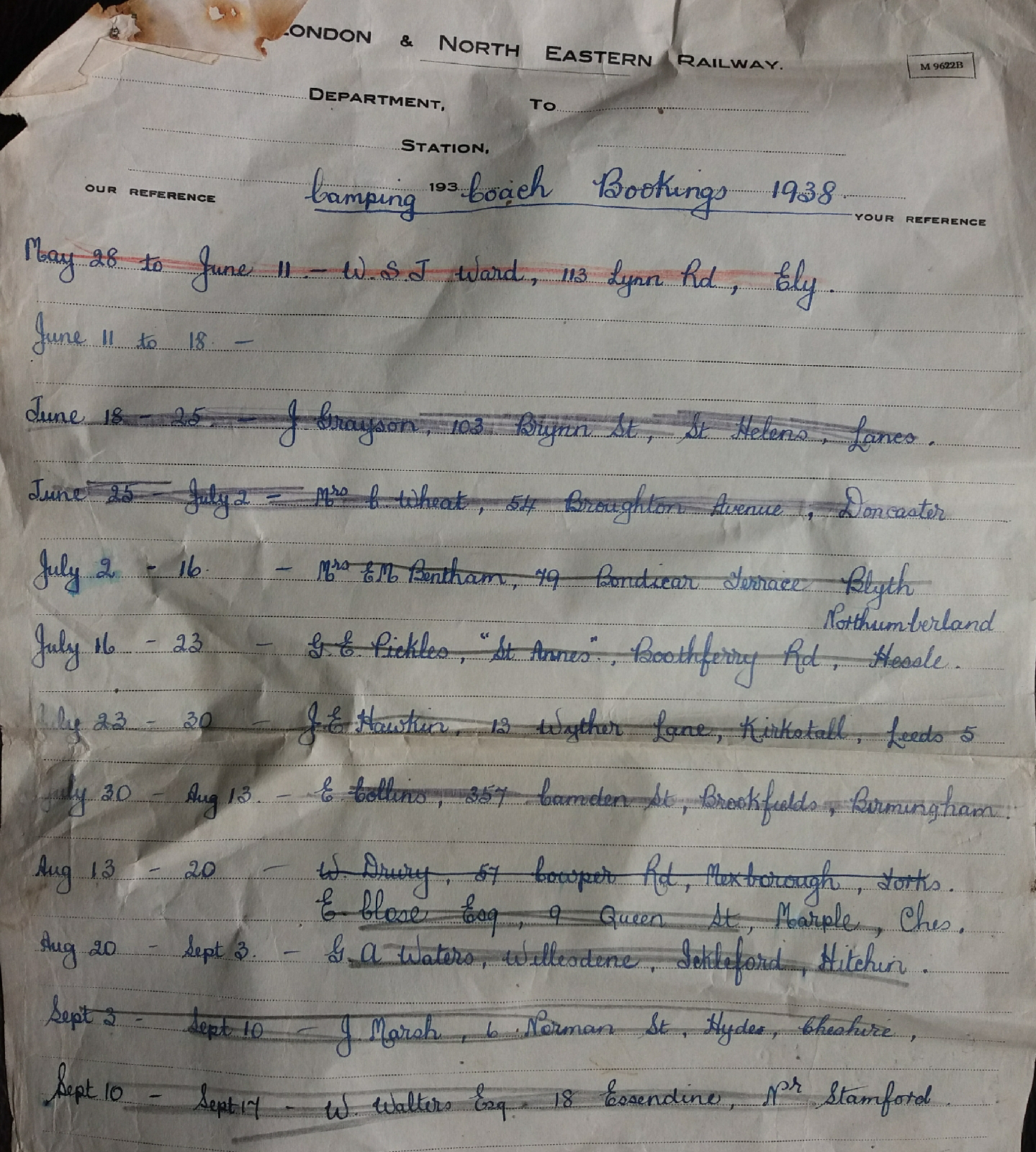LNER Camping Coaches
In 1933 the London & North Eastern Railway came up with the novel concept of renting out some of it's withdrawn vintage rolling stock, after conversion, as holiday accomodation. Veteran carriages, mainly of Great Northern, Manchester Sheffield & Lincolnshire origins, and to a lesser extent those of Great Eastern, East Coast Joint, and Great Central heritage, were thus deployed to sidings around their network. Three of these were based in Lincolnshire at: Woodhall Junction, Seacroft, and Theddlethorpe, the latter being illustrated below.
An example of LNER publicity for these can be seen from extracts from the 1935 booklet below.
Rental of these would require a valid rail ticket per person to the location of the carriages. Two types of carriage were available. For £2 10s 0d per week the carriage would require guests to exit the "Day Compartment" to access the bedrooms. £3 0s 0d would gain the user "superior" accommodation, the carriage being equipped with an internal corridor.
As can be seen from the 1935 leaflet, the "superior" carriages being marked thus * , that at Woodhall Junction being of the first type.
All Coaches were well equipped and it was the responsibility of the respective station staff to ensure all was in place. I do not have the documentation as to what the proceedure was if one of the dozen teaspoons had gone astray!
It would be expected that Woodhall Junction was popular with Anglers. For some reason it appears not to have been well patronised as it was only there for the 1935 season. It could be speculated that lack of internal corridor connection and having to use steps to transfer to the bedroom section, possibly in darkness, may have had something to do with its lack of popularity?
Theddlethorpe had already been earmarked as a possible location in 1934 when, if requested by a customer, one of the then mobile carriages, could be allocated there if required. Clearly there was a demand, as one was allocated there every subsequent year from 1935 - 1939. That illustrated in the first picture in this artice was No. 13, new to the Manchester Sheffield & Lincolnshire Railway in 1886 as their number 51080, and was converted by the LNER in 1934.
As with Woodhall Junction, at present I do not have details as to the actual carriage allocated to Seacroft. Fortunately, I do have a lot of documentation to the latter. At the end of each season, carriages were removed and replaced, if popular the previous year (or not, in the case of Woodhall Junction). It is therefore quite possible that a number of carriages were involved.
Of interest, the Seacroft carriage appears to have been under the control of the Station Master at Wainfleet rather than nearby Skegness, presumably due to the latter being too busy dealing with the day-to-day operations at a very busy station.
The choice of Seacroft may be a little surpising as it is some distance from the sea, shops, or nearest hostelry. It would certainly have been the ideal retreat if one wanted peace and quiet and didn't mind the many passing trains to/from Skegness.
The LNER Company were meticulous in keeping their staff informed of all details involved in having a Camping Coach.
As part of the operation, used linen was despatched by train to the LNER's Laundry at Colchester and replaced by clean linen from the same location.
All items were meticulously recorded.
The 1935 list of renters I have is blank - am presuming this is a spare sheet rather than a reflection of any lack of popularity as, like Theddlethorpe, Seacroft had a carriage allocated every year from 1935 - 1939, inclusive. I do have lists for guests for the years 1937/8 shown below. Note the clarity of handwriting from an era when this, and clear English, were regarded as paramount in the educational system.
Certainly in the case of Lincolnshire, the allocation of Camping Coaches utilised a period when the sidings at the respective stations were not heavily utilised by wagon loads of agricultual produce, as is all too evident when looking at the record of wagons which used the sole siding at Seacroft.
Amongst publicity produced by the LNER, was this book dated April 1936. In its 124 pages, it lists the locations, as well as Youth Hostels and Camping Sites.
An extract from the map with the book shows the Carriages at Seacroft and Theddlethorpe. Whilst they have long since gone, the Youth Hostel at Ruckland still exists.
The mention of Seacroft being just one mile from the beach is a tad optimistic!
The outbreak of War in 1939, effectively ended this enterprise, and post-War economics and Nationalisation drew to a close the end of the era for Camping Coaches in Lincolnshire. British Railways did continue the trade years later at other locations. Happily they still exist on some preserved railways and, most notably, alongside the former Great Western Main Line at Dawlish, albeit no longer run by the railway companies themselves.
I conclude this foray into a bygone era with some LNER posters.
























